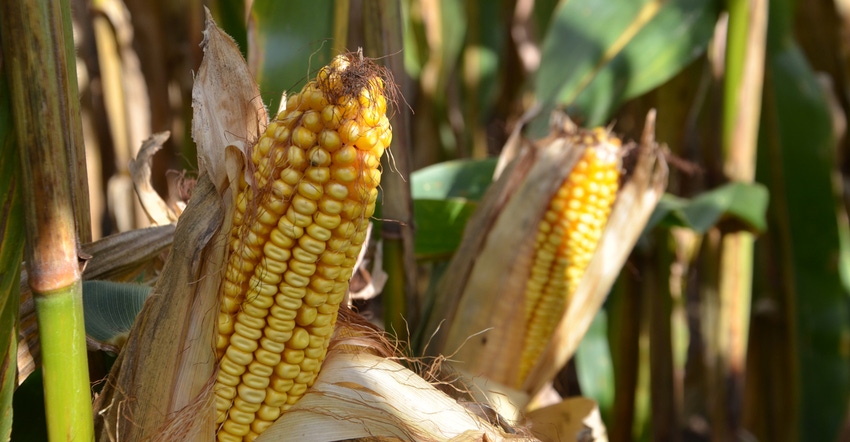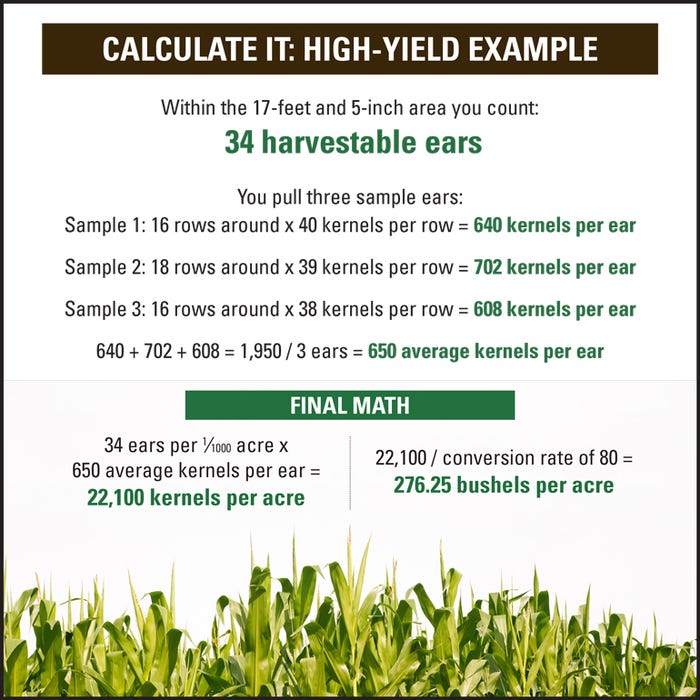
How would you like to harvest 275 bushels per acre at least once in your farming career? Some of you already have. It’s exciting, especially if you do it across an entire field or a whole farm.
The graphic below lays out the math for 276 bushels per acre. It’s based on the time-honored corn yield estimate formula in the Purdue University Extension Corn & Soybean Field Guide. What you see is based on 1/1,000 of an acre in 30-inch rows.
This example features a hybrid that averages 16.67 rows per ear and 39 kernels per row. That’s a girthy, long ear. There are two keys to why the yield in the example reaches 276.25 bushels per acre, says Dave Nanda, director of genetics for Seed Genetics Direct. They are number of harvestable ears per acre and reasonably large kernel size. Here is a closer look:
Harvestable ears per acre. If you assume 95% germination and 5% stand establishment loss due to planter errors or weather-related germination problems, that means you need to plant 37,700 seeds per acre in 30-inch rows.
“Few farmers are planting at those seed populations today,” Nanda says. If you can do a better job of planting and avoid emergence issues, you might be able to drop it back some.
“What we’ve seen in our Corn Watch project over a decade or more is that if you have soils prone to crusting, you can’t count on a perfect stand,” Nanda says. “Invariably, you will find skips here and there down the row. About 80% of the time when I dig, the seed was dropped but didn’t germinate for one reason or another. Too many skips, and you lower the number of harvestable ears quickly.”
Suppose in the same example shown here there are 32 harvestable ears per 1/1,000 acre, not 34. Now final yield would be 260 bushels per acre. If you only have 30 harvestable ears per acre, estimated yield is 244 bushels per acre.

“Another thing we’ve noticed is, even if you get 30 to 34 plants per acre, if a couple or more emerge late, they likely won’t produce harvestable ears,” Nanda says. “Instead, they act as weeds.”
Suppose you have 30 stalks but 28 ears. Yield drops to 227.5 bushels per acre. And if emergence was a bigger issue, as it was in some cases in 2021, and you have 26 ears, yield is 211 bushels per acre.
“That’s why I am advising people planting 32,000 to 34,000 seeds per acre on those type of soils to bump seed count at least 2,500 seeds per acre next year,” Nanda says.
Kernel size. The high-yield example uses 80 as the factor representing kernel size. For decades, specialists used 90 as the factor. However, with modern hybrids and larger kernel size, many suggest 80 or 85 as an average. In some years with little stress during grain fill, it could go to 75. Conversely, if plants are stressed and kernel size shrinks, 95 might be more accurate.
How much difference does that make? At 75, 80, 85, 90 and 95 as factors, respectively, with the same high-yield example in the graph, yields would be 294.5; 276.25; 260; 245.5 and 232.5 bushels per acre. That’s over a 60-bushel swing based on only kernel size.
About the Author(s)
You May Also Like




